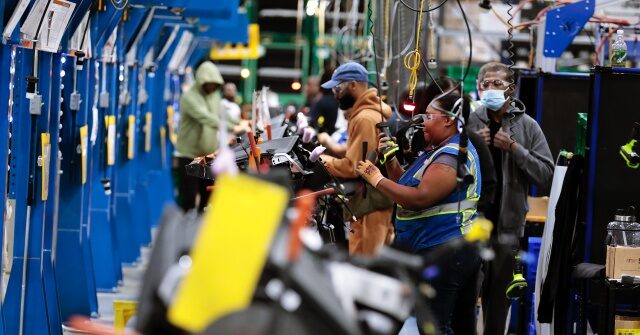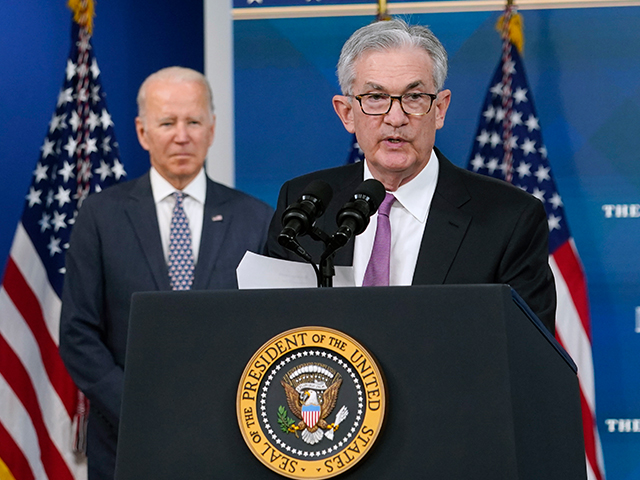
The surprisingly strong January jobs report reflects real employment and productivity growth and not just growth in government or government-adjacent hiring, Breitbart Economics Editor John Carney explained during a Friday interview with Fox Business host Larry Kudlow.
Kudlow opened the discussion with Carney, former Congressional Budget Office (CBO) Director Douglas Holtz-Eakin, and The Shark Tank’s “Mr. Wonderful” Kevin O’Leary of O’Leary Ventures by noting that conservative pundits are trying to dismiss Friday’s blowout jobs report which showed that the economy added 353,000 jobs in January.
“I know a lot of people who are trying to shoot holes in this and shoot it down,” Kudlow said. “They are, shall we say, of the conservative persuasion. They are people who I will say do not wish Joe Biden to be reelected. I don’t think they wish him harm. They don’t want him reelected. But I looked at these numbers up and down, and I made some calls. And as far as these numbers go, which are always subject to revision, they look pretty real to me.”
”Yes, they’re very real,” Carney agreed. “If I take out all of the government jobs, just 36,000, [and] If I take out all the government-adjacent jobs—so the social assistance—I come down to just 217,000 jobs. That’s a really good jobs report even if you take out all of the maybe non-cyclically related jobs.”
Carney broke down the jobs numbers and debunked the various conspiracies about them in Friday’s Breitbart Business Digest (emphasis in the original):
Importantly, job growth was widespread. In January, professional and business services expanded by 74,000, manufacturing grew by an impressive 23,000, retail trade was up 45,000.
[…]While it has been fashionable to complain that too many of the gains in employment are government jobs—and therefore not a sign of the health of the private sector—that does not appear to be the case in January. Government employment rose by 36,000, below the 56,000 average last year. That included 11,000 federal hires and 19,000 state and local hires excluding education.
Private payrolls, on the other hand, grew by 317,000, crushing expectations for 142,000.
Even if we exclude what we have sometimes called the “government-adjacent sectors”—social assistance, health care, and education—then the private sector still added 217,000 jobs. The reason those get excluded in some analyses is that many of the jobs are non-cyclical, meaning not indicative of the growth of the economy. That’s likely only partly true, however, because a good deal of spending on those services is discretionary and therefore is responsive to economic cycles.
These jobs numbers are not only “real” but also “picking up steam,” Kudlow observed.
Carney agreed and emphasized that this means an interest rate cut from the Federal Reserve is likely nowhere in sight. At his press conference this week, Fed Chairman Jerome Powell dashed the market’s hopes of a cut after the Fed’s March meeting. But these jobs numbers may have poured cold water on any cut before the November election, Carney argued.
“What I think this means is not only is the March cut off the table. The May cut us off the table, [and] maybe the June cut,” Carney said. “If the Fed doesn’t cut by July, I don’t think they cut at all until after the election. The November meeting starts the day after Election Day. They pushed it back a day. It’s usually Tuesday-Wednesday. It’s Wednesday-Thursday in November.”
Former CBO Director Douglas Holtz-Eakin noted that the most important data to focus on is not the jobs numbers but the surprising growth in productivity.
“The numbers are the numbers, and I was as surprised as anybody by these numbers,” Holtz-Eakin said. “I think the really important number is not the one in this report… It’s the productivity growth. The productivity growth in 2023 second half especially has come out of nowhere. And productivity growth gives you a great luxury. It allows you to have a Fed put in a lot of restraint on demand and still have output growth without giving up the disinflation.”
“So, everything broke the way of growth and disinflation in 2023,” Holtz-Eakin continued. “My caution is: Things don’t usually break your way all the time. I mean, there’s going be some bad news in the next couple of months, and we should be prepared for that. And I think that’s why the Fed is extremely cautious. They have an economy that could very well have some inflationary pressures come back, and they don’t want to ease off too quickly.”
O’Leary offered his take on what is driving this unexpected productivity boom.
“I’m speculating that it’s the digitization of the American economy that occurred during the pandemic,” he said. “Margins all across the board in S&P 500 companies and in small businesses have improved about two and a half percent because they’ve cut out the middlemen in distribution to direct to consumer models and direct B2B models. You see that everywhere—whether you’re looking at Nike or a business doing 500 million in sales anywhere in America.”

Federal Reserve Chairman Jerome Powell speaks after President Joe Biden announced Powell’s nomination for a second four-year term as Federal Reserve chair on Nov. 22, 2021. (AP Photo/Susan Walsh)
He also predicted that this jobs report “puts a nail in the coffin” of a May rate cut from the Fed.
“This puts a nail in the coffin of anybody thinking they’re going to cut rates in May,” he said. “You have a 75 percent productivity. There are people betting that they’ll cut rates. In fact, the market thinks there’s three cuts—25 bips each—coming right after the March [Fed meeting], which is a zero probability of a cut. I don’t see it.”
O’Leary argued that the Fed risks appearing political if they attempt a rate cut in an election year when all of the data shows that the economy is heating up.
“It is going to be political,” he said. “The incumbent wants to talk about the economy, wants to talk about jobs, but never ever do they want to be in a rising rate environment. They want the Fed to cut rates. So, the pressure politically on the Fed cutting is going to be very high, particularly as you roll in to Q3 when it’s magic to have a rate cut right before you’re in the ballot booth.”
Carney agreed with Holtz-Eakin’s emphasis on the importance of productivity growth and O’Leary’s assertion that the Fed won’t be cutting rates anytime soon.
“All of the goods disinflation is pretty much washed out of the economy. Everything you were going to get from maybe increasing worker participation washed out of the economy,” Carney said. “Unless we get more productivity, we will get more inflation. So, if we keep growing productivity—which, by the way, nobody knows why it’s happening, as we were just exploring, and we don’t know whether it can continue. So, that’s the big risk. That’s what Jay Powell is afraid of. They don’t want to cut and then have to come back and raise. So, they are going to hold out. I think Kevin O’Leary is absolutely right. No cut in May. No cut in June.”
“They’re not going to get a cut in my lifetime,” Kudlow quipped.
“Seriously, rates may be permanently higher. That’s one of the things we may have to get used to,” Carney said.
Rebecca Mansour is a Senior Editor-at-Large for Breitbart News. Follow her on X at @RAMansour.
